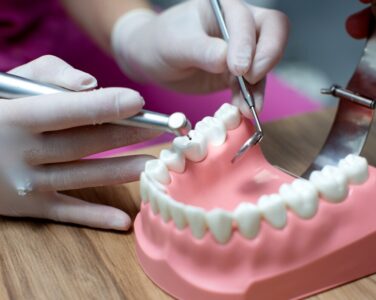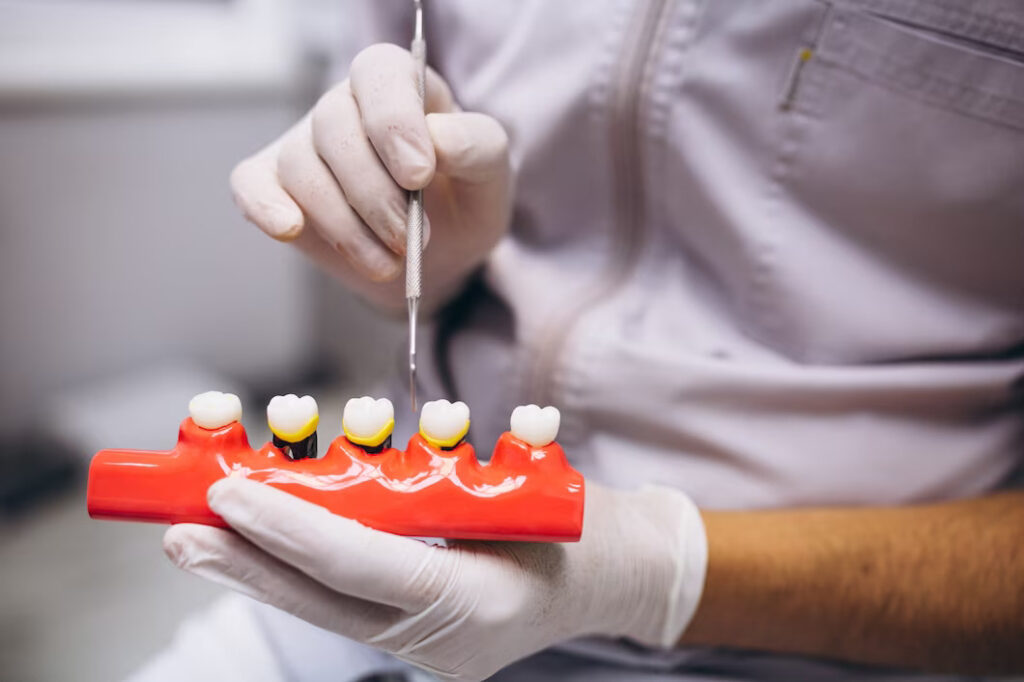Introduction
Have you ever seen someone smile and wondered why they were missing a tooth or two? According to the Australian Institute of Health and Welfare (AIHW), more than 17% of Australians aged 15 and older have missing teeth. As we become older, it’s not unusual to find ourselves in the same situation. So, that’s where complete and partial dentures come in with a blend of dental knowledge and craftsmanship that not only restores smiles (teeth) but also promotes confidence and comfort. In this blog, we will look at the interesting realm of designing complete and partial dentures.
The Artistry Behind Complete Dentures and Partial Dentures
Beyond function, let’s explore the artistry that restores smiles with dentures.
Complete Dentures
A complete denture, also known as a full denture, is a removable dental device used when all of the teeth in a jaw are lost or removed and need to be prosthetically replaced. It is of mainly 2 types: Conventional and Immediate. The immediate ones are made for placement right after the removal of teeth. After around 8 to 12 weeks of the teeth removal, the conventional dentures can be placed in your mouth.
Parts of a Complete Denture
Understanding the various parts of complete dentures include:
- Artificial teeth: These work similarly to normal teeth, allowing you to bite and chew food as you would before having a tooth extraction. Also, they can be constructed using porcelain or acrylic, helping you restore the look of your natural teeth.
- Denture base: Made of polymethyl methacrylate (PMMA) this serves as a foundation for your artificial teeth and helps restore damaged soft and hard tissues.
( As your upper and lower jaws are slightly different, your denture will also have these intricate differences)
- Full upper denture: The top part of your full denture. It covers the roof of your mouth and is known as the maxillary arch.
- Full lower denture: Horseshoe-shaped lower portion of your denture, known as the mandibular arch. It snugly fits on your gums and underlying bone.
How Are Complete Dentures Made?
Designing a complete denture requires a collaborative effort between you and your dental team. Here’s a breakdown of the process:
- Your dentist will take a mould of your mouth using plastic or wax. Then the fit, shape, and even the colour will be checked with you beforehand. A device called an articulator is used to attach the teeth to the wax.
- This wax model will further be shaped and carved to mimic your gums.
- The model is then put in a flask and filled with plaster to hold the shape. Then hot water is poured to melt away the waxy model, leaving a structure for the final denture.
- Following up, a liquid separator is added to the plaster layer. It helps prevent the acrylic from getting stuck to it as the acrylic is injected into the flask.
- After the mould hardens, the technician gently breaks away the plaster using special tools. Then, they dip the new dentures in an ultrasonic bath, washing away any tiny bits of plaster left behind.
- This denture then gets polished and trimmed. It is ready to be tried on for the initial fitting.
Partial Dentures
Partial dentures are used to bridge the gap between one or more missing teeth. They are often secured using clasps that attach to the surrounding natural teeth. Regarding the types of partial dentures, it is broadly categorised into two groups; Removable and Fixed. Removable partial dentures are designed to be inserted and withdrawn from the mouth. As they cannot be firmly linked to the teeth. Whereas fixed partial dentures are a semi-permanent method for replacing one or more lost teeth.
Parts of a Partial Denture
The basic components of a partial denture include:
- Denture base: The base surrounds the ridge of your mouth that has a gap between the teeth. The foundation of acrylic partial dentures is often constructed of acrylic resin or metal (chrome cobalt).
- Denture teeth: Made with porcelain or acrylic, they serve as the replacement for the missing teeth.
- Major connector: This framework connects all of the components of a partial denture, keeping it firm.
- Minor connector: it connects every other component to the major one.
- Rest: It is a component of a removable partial denture that sits on an already prepared tooth surface. The rest’s job is to distribute force along the tooth, ensuring that the denture stays in place.
- Clasps: Allow the denture to withstand dislodging forces in your mouth(in the vertical direction).
How Are Partial Dentures Made?
The design of full and partial dentures are similar but below are the steps that might differ in the case of partial dentures:
- Your remaining teeth act as the anchor to create your partial dentures and they need to be as healthy as possible.
- Impressions of your mouth are taken for a custom fit and sent to the lab. Making partial dentures necessitates a series of customised impressions to guarantee that the dentures fit your mouth precisely.
(Then mostly the same process is followed as a complete denture to prepare your partial dentures.)
As we finish it off, it is critical to note the different types of dentures have different lifespans and you will need to make adjustments accordingly. So, here’s a table decoding full dentures and partial dentures in terms of their longevity.
| Types of Dentures | Life-span |
| Complete Denture | |
| Immediate Complete Denture | 6-8 months |
| Conventional Complete Denture | 6-10.1 years |
| Partial Denture | |
| Removal Partial Denture | 5-7 years |
| Fixed Partial Denture | 9-10.4 years |
It is always important to seek quality service when getting your dentures, after all the world will see you smile. Check out Quick Denture Repair in Perth for the best quality complete and partial denture sets that will help you feel confident like no other!


